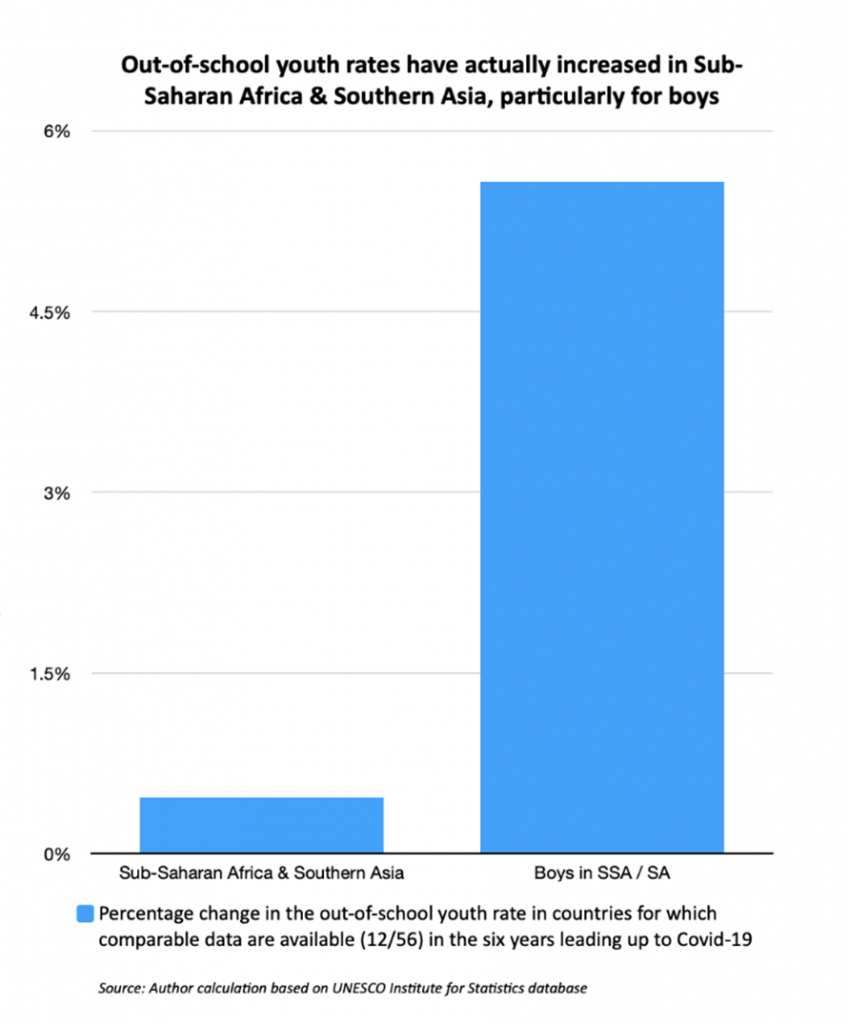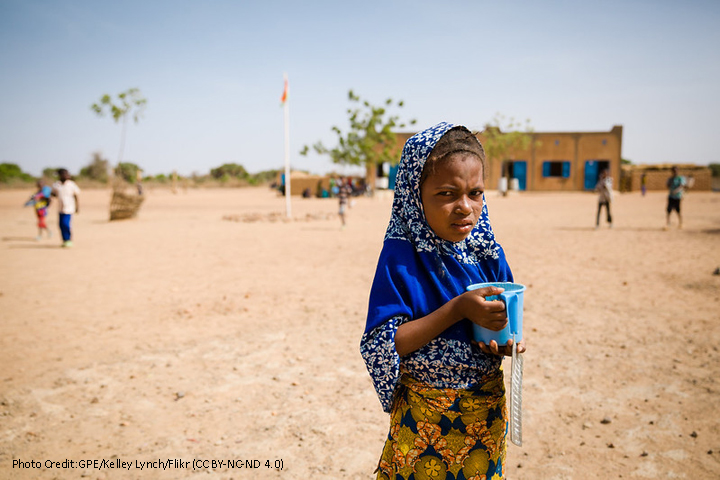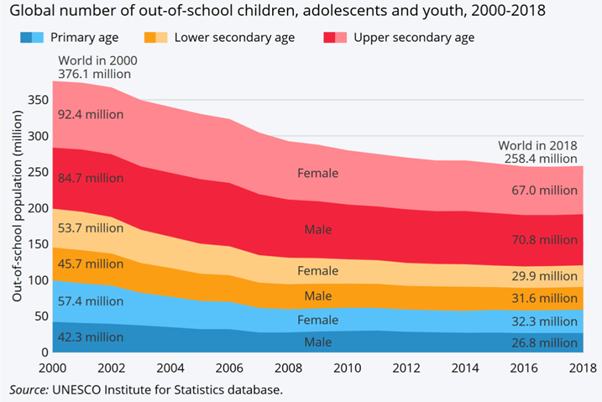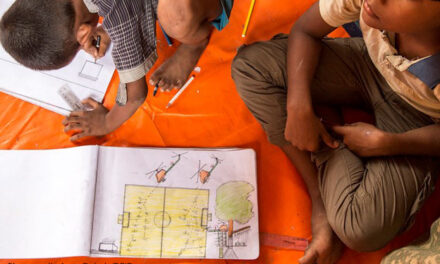This article was written by Andrew Christensen, Dr Carla Pezzulo, Professor Andy Tatem, Dr Victor Alegana and Omar Bakari, academics and practitioners working in education policy, disability rights, public health, and geospatial and data science. It was originally published on the World Education Blog on 2 April 2021.
School closures during the pandemic have affected hundreds of millions. But the out-of-school crisis stretched way before the virus, and it may last long after it, unless we think differently about school access.
Before the virus, there had been a virtual standstill on out-of-school youth rates for almost a decade, and the world was already due to fall far short of its universal secondary school target by 2030.
The sheer size and persistence of out-of-school rates suggests that we were already missing something major before the arrival of COVID-19. Estimates suggest that 199 million youth of secondary school age (about 12 to 17 years old) were already out of school pre-pandemic, and that, tragically, the proportion of the secondary school age population that was out of school had scarcely gone down since 2012.
 When you zoom in, the numbers cause more alarm: before Covid-19, in the regions where most out-of-school youth live, out-of-school rates had actually slightly increased since 2014. Almost three out of four out-of-school youth of secondary school age live in Sub-Saharan Africa and Southern Asia, and out-of-school rates for countries in those regions where data are available slightly increased (0.4%) in the six years preceding Covid-19; for boys, out-of-school rates increased by almost 6%, which may possibly be driven by child labour trends in Nepal, Benin, Senegal, Lesotho and Zimbabwe.
When you zoom in, the numbers cause more alarm: before Covid-19, in the regions where most out-of-school youth live, out-of-school rates had actually slightly increased since 2014. Almost three out of four out-of-school youth of secondary school age live in Sub-Saharan Africa and Southern Asia, and out-of-school rates for countries in those regions where data are available slightly increased (0.4%) in the six years preceding Covid-19; for boys, out-of-school rates increased by almost 6%, which may possibly be driven by child labour trends in Nepal, Benin, Senegal, Lesotho and Zimbabwe.
Secondary education transforms lives, health, and livelihoods, but policies seem to be missing the mark. Building more bricks and mortar and introducing fee-free schooling were the start of the journey, but the remaining miles to achieving universal secondary will require much more nuance in tackling the geographic variation and less visible barriers to access.
Policies miss the mark. The SDGs include universal secondary education, but this is nearly absent from the country agendas which were analysed in the Global Education Monitoring Report, Beyond Commitments, released just before the pandemic. Secondary age out-of-school youth constitute approximately 77% of out-of-school children, but only 19% of education aid is spent on secondary education. Policy is missing proportion and priority.
Challenges for universal secondary access differ from primary to an important degree, and policies should be tailored accordingly. Gendered norms have high consequences in adolescence: child-bearing and labor market entry compete with school attendance and alter life trajectories. Costs of secondary schooling to households are greater, barriers to entry are higher (i.e. entrance exams, inadequate sanitation facilities for menstrual hygiene management), behavior is more difficult to influence, and there is also a prevalent perception that after primary ends, education is ‘complete’.
Policy needs to think about generations to come, but not forget about the generation that is present. Investment in foundational learning skills should span not only primary, but also secondary age groups, especially when three of four of those who are out of school are teenagers. Reviews suggest policy should not only emphasise retaining at-risk youth in school, but also consider remediation through formal or alternative education (i.e. second-chance, equivalency programs) and integration with the labor market.
To meet the magnitude of the challenge, we need to track within countries, not just between them. Out-of-school numbers and their causes differ from place to place and between groups within countries, but policy typically does not. Policy must consider geography: in the first two decades of this century, geographic disparity in educational attainment actually increased within some countries. Novel geospatial research has made headway (see GRID3 and IIEP-UNESCO) and multivariate modelling makes inroads, but many methods have not been applied to the extent they need to in order for policymakers to tackle the crisis with greater geographic and intersectional nuance.
Reaching universal secondary education requires policy that accounts for the often hidden and complex barriers faced by different groups. Barriers differ between groups (e.g. across gender, disability, ethnicity) and those barriers affect youth in different, often compounding, ways. Hidden costs to households are not only foregone labor market opportunities, but the price of uniforms, school supplies, shoes, and ‘voluntary’ – but informally obligatory – parental fees. Attitudes block access, not only through gender norming of girls, but also through negative stereotyping of youth with disabilities. Policy can do more to account for these subtle differences, and the benefits of doing so would be large.
Achieving universal access to secondary education would bend world history. Take Sub-Saharan Africa alone: this region will account for most of the growth of the world’s population over the coming decades, and many estimates suggest that by 2050, it will have more youth than any other region in the world. Demographic transitions like this can yield large dividends, and education is necessary to unlock those dividends.
Secondary education transforms lives: we know this from a human rights perspective, but it is also borne out empirically. Education improves health, and estimates suggest private economic returns to education are high globally, and highest for both girls and boys in Sub-Saharan Africa, particularly for secondary education.
The cumulative effect of universal secondary will be large, but we need big change to get there – the numbers, even before Covid-19, suggest that reaching universal access requires a change in course: we not only need budgets that account for the sheer magnitude of the crisis, but we also need policy that tackles geographic and gender inequality, and disparity due to disability.
This is not an easy ask. But as kids head back to school after Covid-19, let us not forget about those who were out of school to begin with.
——————-
The collaboration of the authors on the out-of-school crisis is funded in part by the The Garbett Family Foundation and the United Kingdom’s Economic and Social Research Council Impact Acceleration Account at the University of Southampton. This written piece is the authors’ own, and does not necessarily reflect the opinion of the funding partners or the authors’ respective organisations.






